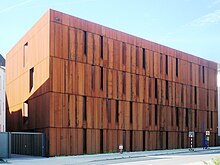House of Essen History / City Archives
| House of Essen History / City Archives
|
|
|---|---|
 House of Essen history in the former Luisenschule |
|
| Archive type | Municipal Archives |
| Coordinates | 51 ° 26 '59.9 " N , 7 ° 0' 23.6" E |
| place | eat |
| Visitor address | Ernst-Schmidt-Platz 1 |
| founding | around 13th century |
| scope | 17 km |
| Age of the archive material | 13th century until today |
| carrier | City of Essen |
| Website | http://www.essen.de/stadtarchiv |
The Haus der Essener Geschichte / Stadtarchiv is the central documentation center for the history of the city, which also serves as a research unit and information center on the history of the city of Essen . The Haus der Essener Geschichte archives archive material from the committees and offices of the city of Essen as well as archive material from numerous other bodies, such as companies, associations, individuals, trade unions and parties related to Essen.
History of the city archive
The city archive of the city of Essen has its roots in the 13th century at the time of city development. The oldest document is a parchment certificate from 1272, in which the twelve councilors of the city of Essen are named for the first time. For many years there were no separate rooms in the town hall for the city's archives . Many documents were kept by the respective city secretaries and not archived in a uniform manner.
It was not until the Prussians occupied the city in 1802 that they had all the city documents stored in an adjoining room in what was then the town hall, but they continued to be disorganized. At the beginning of the 19th century, many documents were lost, the value of which had probably not been correctly assessed, as they were sold to paper mills to improve the city's coffers. In the middle of the 19th century, the mayor Bertram Pfeiffer , the secretary Petersen and the dean Butzon began proper archiving work, which Conrad Ribbeck continued. He was chairman of the historical association for the city and monastery of Essen , a history teacher at the Burggymnasium and author of the history of the city of Essen , which the city of Essen published in 1915. In 1936 Robert Jahns was the first to take full-time management of the city archive. He was followed by Hermann Schröter as the first scientifically trained archivist.
In 1940, the city's archives were given their own new premises in what was then the town hall of the architect Peter Zindel on the Flachsmarkt, which a few time later suffered severe destruction during the Second World War . In a fire in the filing room caused by the heavy air raid on March 5, 1943, valuable holdings were lost. When further documents from the 19th and 20th centuries were added to the archive after the war, space became too tight. The city set up the new Essen city archive in the rabbi house of the Old Synagogue . Finally, at the beginning of 2010, the building of the Luisenschule , which was erected between 1903 and 1906 and which was closed in 2004 and which is now a listed building , moved.
Today's archive
The so-called House of Essen History, the Essen City Archives, has been located on two of the four floors of the former Luisenschule since 2010, with a museum, library, offices and workshops. These include the Hindenburg home collection, the historical association for the city and monastery of Essen and the West German Society for Family Studies, Essen district group. In addition to the permanent exhibition Essen - History of a Big City in the 20th Century, with a special focus on the National Socialist era, there are temporary exhibitions.
The four-story warehouse building, which was built from 2008 to 2009 and designed by the architects Frank Ahlbrecht and Hermann Scheidt, structurally closes the gap in the former school block created during the Second World War. Characterized by its façade made of striking COR-TEN steel , the archive rooms with 17 kilometers of shelves in the city's archives are air-conditioned with computer-aided control, with the help of external temperature sensors and other measuring devices. Each floor can be ventilated separately from the outside or supplied with heating. The rear-ventilated steel facade keeps moisture and heat away from direct sunlight. The steel outer skin, which is constantly changing due to corrosion, represents the changing times and creates a reference to the former Kruppstadt Essen.
Web links
- Homepage of the city of Essen: House of Essen history / city archive
- Information on archive NRW
- Architecture NRW
Individual evidence
- ↑ a b c Homepage of the city of Essen: The history of the city archive ; Retrieved May 3, 2014.
- ↑ Luisenschule in the list of monuments of the city of Essen (PDF; 538 kB); accessed on January 16, 2020
